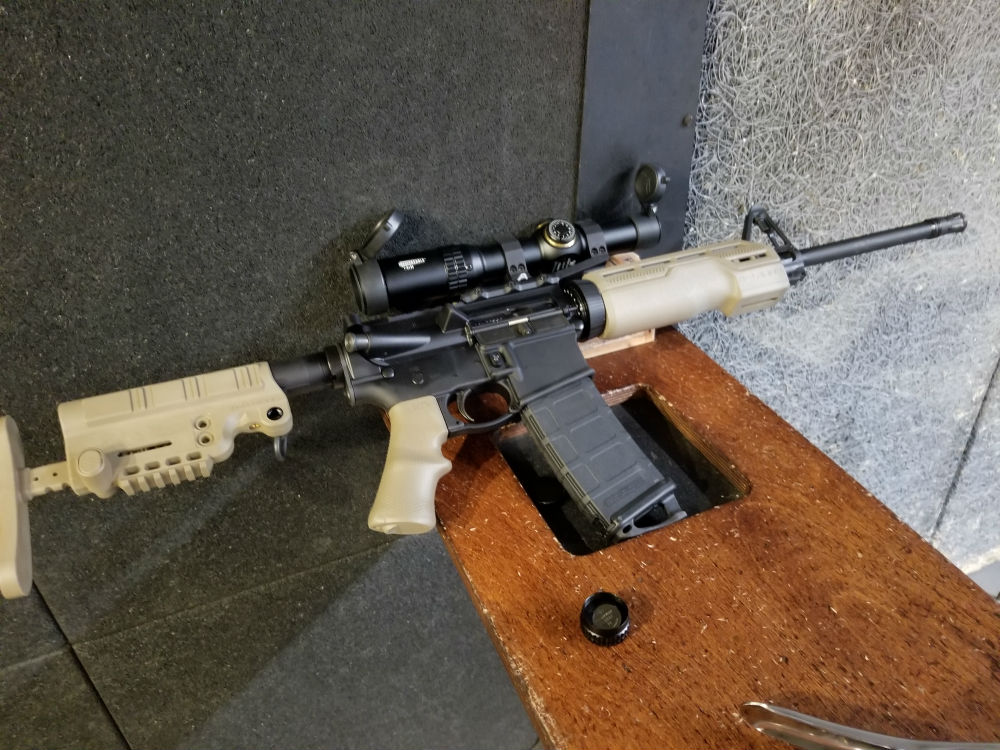
By John Crump
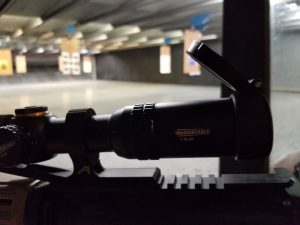 I am a big fan of Vortex optics. I run a few of their optics on my guns. On the Glock 17 Reaper project, I use a Vortex Viper. On my CZ Scorpion, I have a SPARC II. A lot of people do not have the funds to spend a lot of money on an optic. Vortex makes a lot of quality optics at affordable prices.
I am a big fan of Vortex optics. I run a few of their optics on my guns. On the Glock 17 Reaper project, I use a Vortex Viper. On my CZ Scorpion, I have a SPARC II. A lot of people do not have the funds to spend a lot of money on an optic. Vortex makes a lot of quality optics at affordable prices.
When I got the chance to try the Vortex Strike Eagle I jumped on it. Vortex was kind enough to provide me one for testing and evaluation. To be 100% transparent one of my good friends has one on his wife’s AR15 and constantly raves about it. I don’t take anyone’s word for it, so I had to try it out for myself.
The Vortex Strike Eagle purposed built for the AR15 platform. The Strike Eagle comes in 1-6×24 and 1-8×24 respectively. The one I received was the 1-6×24 which I was fine with since I was going to use the Strike Eagle at 100 yards maximum due to range limitations.
The cool thing about the Vortex Strike Eagle is that can be employed not only at long range, but the scope can be utilized at an almost point-blank range on a target. This scope is perfect to engage targets inside or outside a building without having to worry too much about adjusting your holds coupled with the illumination options of the reticle. The Strike Eagle is an all-purpose scope.
The optical tube on the Strike Eagle is made out of airplane grade aluminum. The aluminum is anodized with a matte finish to cut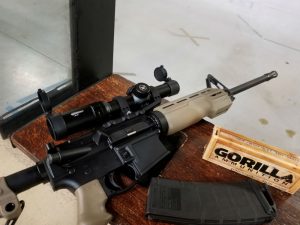 down on glare that can give away the shooting position of the shooter. This scope is built not to be just a range toy but something that can take a beating in an operational duty setting.
down on glare that can give away the shooting position of the shooter. This scope is built not to be just a range toy but something that can take a beating in an operational duty setting.
The tube of the Strike Eagle is made in one piece. I like this about the Strike Eagle because it makes it tough with fewer points of failure. Another thing that this one-piece design does is it helps with accuracy. This increased accuracy is because a single tube design is going to have fewer defects that could affect part alignment.
Another thing the single tube design of the Strike Eagle does is improve the water resistance of the scope. I placed the scope underwater for 48 hours to check the Vortex claim that it is waterproof. When I removed the scope from the water and checked to see if any got into the tube, I was happy to see none did. I only tested it in about a foot of water, but that should be enough to prove that the rain will not damage the scope.
Vortex treated the glass of the Strike Eagle with an anti-reflective coating to cut down on the fogging up of the lenses. Then they a used nitrogen purging process to further cut down on fogging internally. While running around inside and outside with the optic, it did not fog up on me once. It is worth noting this test was done after the optic was soaked in a bathtub for two days which could have affected an inferior fog resistant coating.
Vortex etched the reticle onto the glass of the Strike Eagle. Vortex also illuminated the reticle. It has a center halo that Vortex told me helps shooters acquire targets. For me, it did speed up my target acquisitions, but not as fast as it sped up the target acquisition of my 3-gun friends. It might be that I just need to get used to it, but it did make it faster than just a standard red dot.
Vortex does recommend that the Strike Eagle’s main crosshair should be zeroed in at 50 yards. This way the shooter can use the hash marks to engage targets at a longer range up to 600 yards. The main crosshairs are used to engage targets from 20 to 200 yards.
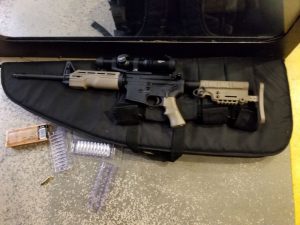 Using 5.56mm/.223 ammunition the first drop first hash mark of the Strike Eagle is used for targets at 300 yards. The second hashmark is used for 400 yards, the third for 500 yards, and forth for 600 yards. The drawback is that the hash marks only work with the scope at 6x. The hash marks will not be accurate if the optic is set to any other magnifications. It is worth noting if firing out of an AR10 (7.62 mm/.308) the hash marks represent 230/330/440/570 yards.
Using 5.56mm/.223 ammunition the first drop first hash mark of the Strike Eagle is used for targets at 300 yards. The second hashmark is used for 400 yards, the third for 500 yards, and forth for 600 yards. The drawback is that the hash marks only work with the scope at 6x. The hash marks will not be accurate if the optic is set to any other magnifications. It is worth noting if firing out of an AR10 (7.62 mm/.308) the hash marks represent 230/330/440/570 yards.
So the big question is why did I dial the Vortex Strike Eagle in at 100 yards instead of 50 yards? When I followed the manual and zero’ed in at 50 yards, I was high at 100 yards. Per the advice, I got when I interview I did with Eric Dorenbush who has taught the best of the best in the world I sighted it in at 100 yards. I was using Warne’s LR-Skel 30mm scope mount. It was straightforward to sight the scope in where I wanted it. It took me only five rounds of Gorilla ammo to get it fixed on the target at 100 yards. I fired another 25 rounds, and it held zero.
The Vortex Strike Eagle lets you adjust for windage and elevation. Each click of the is 1/2 minutes of angle (MOA). One MOA is equal to 1.05 inches at 100 yards. This adjustment means if you are two inches high at 100 yards you will adjust four clicks down (two MOA). The same can be done on the Strike Eagle for windage.
I decided to put the Vortex Strike Eagle through a full days workout at an outdoor range and then moved on to an indoor range. This gave me a chance to play with the illumination of the reticle. The scope has 11 different levels of brightness. According to Vortex at the maximum setting, the battery will last for 150 hours.
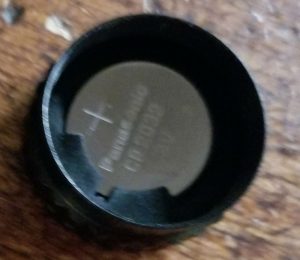 One cool thing that Vortex included on the Strike Eagle is a storage compartment for a spare battery under the windage turret cap. This feature hits home because I was taking a shooting class and had a dead battery in one of my optics, so I had to run to Walmart to buy a battery. The Strike Eagle uses a CR2032 battery.
One cool thing that Vortex included on the Strike Eagle is a storage compartment for a spare battery under the windage turret cap. This feature hits home because I was taking a shooting class and had a dead battery in one of my optics, so I had to run to Walmart to buy a battery. The Strike Eagle uses a CR2032 battery.
I was able to acquire targets from 15 yards to 100 yards without issue. Changing targets with the Vortex Strike Eagle was smooth and easy. I was able to shoot a target then move and pick up another target without issue. I would have loved to engage targets out to 600 yards, but I did not have access to a range that extended to 600 yards.
Once I crossed the 15-yard mark going closer to 10 yards I did experience the dreaded fisheye effect with the Strike Eagle. At this close range, it actually wouldn’t cause you to miss your shot. In all honesty, the fisheye wasn’t that bad. It was just a little annoying, but it isn’t a deal breaker.
As I said previously in the review, the design of the reticle of the Vortex Strike Eagle makes it easy to acquire and engage targets. Throughout the day I got fast and faster at acquiring the target and putting lead down range. I think the more I use it, the faster I will become with the Strike Eagle.
After a full day of shooting several hundred rounds, the Strike Eagle stood up to the recoil and held zero as a scope should. This is the most important thing any optic can do. It was bumped and mistreated all day and didn’t fail.
The one thing that is a drawback of the Vortex Strike Eagle is at longer range is that there is no way of adjusting for parallax. I didn’t find this to be a major issue, but it is worth noting. For most shooters going to the range, this will be a non-issue.
Another drawback of the Strike Eagle is that I had to remove the Ruger backup sight to get the Strike Eagle mounted. Once again this wasn’t a big deal on the rifle I had it installed on, but if you are a person that likes the safety of having backup sights in case something happens to their main optic you might have to spend money on a backup sight that rides lower than the Ruger sight.
The biggest advantage is the price. At the time of this writing, The Vortex Strike Eagle has an MSRP of $569.99 for the 1-8×24 and $449.99 for the 1-6×24. These prices are MSRP so you should be able to find both these optics at lower prices. Compare this to the Vortex Razor HD Gen 2 which has the MSRP of $1999, and you can see the savings.
This by far is my favorite Vortex optic. The Strike Eagle is a purpose-built optic that comes through and punches above its weight class. I am incredibly happy with this scope. This will be put into heavy rotation on my shooting platforms.
The Vortex Strike Eagle can be found at http://www.vortexoptics.com/